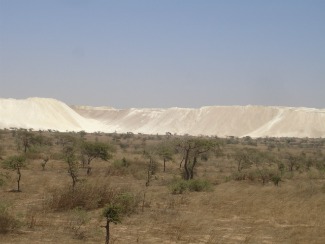The human-induced imbalance between Carbon, Nitrogen and Phosphorous

Humans are continuously raising atmospheric CO2 concentrations by increasing fossil fuel combustion. This increase of atmospheric CO2 concentration together with the warming effect can stimulate plant production capacity mitigating the rise of atmospheric CO2 increase in a negative feedback. But this capacity to mitigate the rise of atmospheric CO2 is strongly dependent on nutrient availability. Researchers of the Global Ecology Unit CREAF-CSIC have now conducted a study on the nutrient inputs to ecosystems and on their impacts on N and P cycles as a result of the human activities (Peñuelas et al., 2012). The study has evaluated the possible current and future imbalance between N and P and its consequences on Earth’s capacity to fix C and also on the ecosystems structure and function.
N, the main macronutrient, could become a limiting factor in plant primary production capacity to buffer CO2 atmospheric increase. But this possible N deposition may be overcome by the continuous rise of N from human activities coming from fossil fuel burning, crop fertilization and anthropogenic N2 fixation (legume and rice crops). Currently the global anthropogenic N input to biosphere can be estimated in 175-259 Tg N year-1, amount that is closed to the total natural earths N2 fixation capacity including terrestrial and aquatic ecosystems. As a result, of the continuous increases of these human N emissions since the beginning of the industrial revolution, the reactive N atmospheric deposition has increased from 32 Tg N year-1 in 1860 to 112-112 Tg year-1 nowadays, and furthermore, most models project a twofold enhancement of the N deposition by 2050. In spite of this continuous increase of N and CO2 emissions, there are several studies that report no significant increases in global tree growth and global carbon sinks. These results suggest that other factors have overridden the potential growth benefits of a CO2-rich world.
Other factors may have been neglected. Among these factors that are expected to be limiting to net primary world productivity, P appears to have an outstanding role. P is present in the DNA structure, in cell membranes, in many enzymes, in molecules storing and supplying energy and in bones. Despite these crucial roles, it is scarce in the environment. Human activities also fertilize with P the biosphere by crop fertilization, but this human-induced P fertilization is produced at a smaller rate that the increases of C and N. These results in a increase of biosphere N:P ratios. There are two main reasons why P fertilization is less than N fertilization. First, N fertilization are originated from sources that do not seem to have an immediate limit, that are mainly: industrial fertilizers obtained from the Haber-Bosch reaction between atmospheric nitrogen and hydrogen (obtained from water) at elevated pressure, and anthropogenic N2 fixation, while P fertilizers come mainly from phosphate rock with limited occurrence. Second, while N is highly mobile and globally widespread, P compounds are much less mobile and typically confined to specific areas.
Whereas N:P ratio in photosynthetic organisms have great variability (it tends to reach on average molar ratios of 14-16 in plankton and 22-30 in terrestrial and freshwater plants), the fossil fuels, fertilizers and N2 fixation products have a much higher N:P ratios. Fossil fuels are disproportionately richer in N (1000-20000 mg L-1) than in P (at the level of a few mg L-1). Thus whereas annual emissions of N from fossil fuels reached 33 Tg year-1 in 2000, there is no global evidence of a significant P flux from fossil fuels to the atmosphere. Regarding fertilizers, P inputs to the biosphere is ~17 Tg year-1 and it remains more or less constant since 1989. In turn, N inputs from fertilizers are currently considerable higher, 100-136 Tg year-1 and are continuously rising. Thus, whereas global anthropogenic N input is ~ 175-259 Tg year-1, the anthropogenic P input is ~14-17 Tg year-1, making that currently the N:P ratio of human emissions in molar basis is ~ 22.8-44.6. This ratio is nearly twice the average N:P contents ratio of plankton and on average 5-100% greater than the observed optimum soil N:P ratios (~16-22) for the growth of most terrestrial plants. This draws a scenario of increasing P limitation, predominantly in marine ecosystems and also in terrestrial nonagricultural ecosystems. Nonetheless, P may end up becoming limiting even in agricultural lands.
The main source for P fertilizers is mined phosphate rock, whose demand is continuously increasing, and there is an emerging concern about the sustainability of such an increase to guarantee the global food security. The problem may further be worsened by the fact that only five countries hold 90% of the world P reserves, making several very populated regions such as Europe, India or Indonesia completely dependent on P inputs.
Apart from affecting the C storing capacity, an enhancement of N:P ratio can impacts on other ecosystems structural and functional traits. High growth rates demands elevated investment in P-rich ribosomal RNA. Under P limitation, reduced allocation to ribosomal RNA is possible, thus favoring species with lower growth rates in detriment of species with higher growth rates. Moreover, some recent studies show that the N and P availability of the medium can change the composition of DNA. Thus, the human-induced modification of N:P ratio of several ecosystems at world scale might be acting as an evolution driver.


